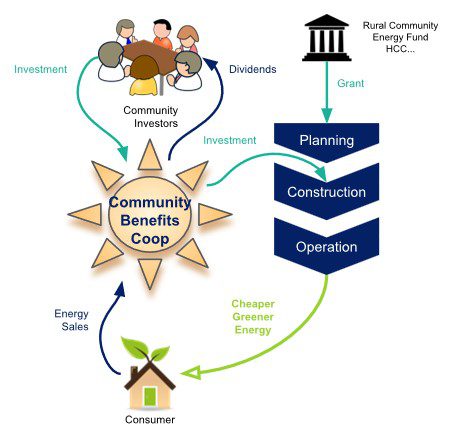The diagram below outlines how community energy projects work:

Planning
The first stage of planning is a feasibility study, followed by detailed design and planning. This phase generally requires grant funding to kick-start the project. The Rural Community Energy Fund (RCEF) has funded the feasibility study for our Thedden Grange project. Unfortunately the RCEF fund has now closed and we are waiting to see what will replace it. There are other sources of funding: Community Energy South have funded the feasibility study for our Coomers project and we are working with EHDC to fund a solar PV project with Eggars School from their Climate Reserve fund.
Construction
Once a project is identified as feasible and has been designed, planned and costed we need to raise capital to fund construction. This is done through a community share offer. We will advertise for local people to invest in each project. They buy community shares in the project in return for a modest dividend (typically ~5%).
A new energy co-operative will be set up to manage the investments. This is likely to be a Community Benefits Society (or Bencom). In a Bencom every investor has a say in how the society is run; crucially though their voting power does not depend on the size of their investment – it is truly one member one vote.
Once the capital has been raised, construction can begin!
Operation
Once the project has been commissioned it still needs to be managed and maintained, through the Bencom. Usually one or more energy consumers (or ‘off-takers’) will have been identified at the feasibility study stage and will have committed to Power Purchase Agreements (or PPAs). These are multi-year contracts for purchasing the clean heat or power and set out the price that they will pay. This revenue is used to fund running costs and dividends to the community investors. Any surplus can be ploughed into new community energy projects or other community benefits.
